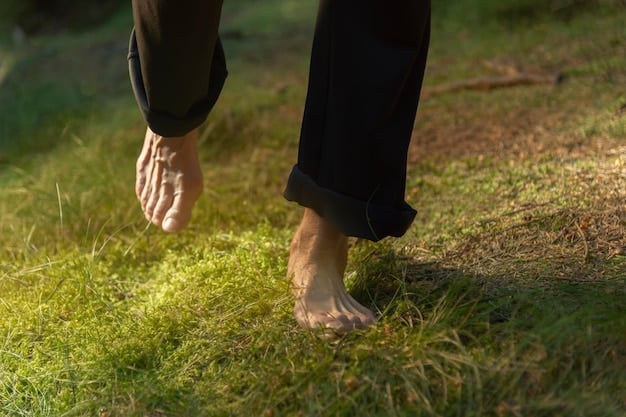Walking Meditation Guide: Benefits & Step-by-Step for Beginners

Walking meditation combines physical movement with mental focus, offering a practical way for beginners to achieve mindfulness, reduce stress, and improve overall well-being, all while gently exercising the body and mind.
Discover the transformative power of walking meditation: A step-by-step guide for beginners. This gentle practice combines the benefits of physical activity with the calming effects of mindfulness, offering a unique way to find peace and clarity in your daily life.
What is Walking Meditation?
Walking meditation is a form of mindfulness practice that involves focusing on the sensations of walking. Instead of concentrating on your thoughts or trying to solve problems, you pay attention to the physical experience of each step.
This practice can be done anywhere, from a quiet park to your own backyard, and it requires no special equipment. It’s a simple yet powerful way to cultivate present moment awareness and reduce stress.
The Core Principles of Walking Meditation
At its heart, walking meditation is about becoming more aware of your body and your surroundings.
It’s not about getting anywhere; it’s about being present in the journey.
- Mindful Movement: Paying attention to the movement of your feet, legs, and body as you walk.
- Breath Awareness: Coordinating your breath with your steps to deepen your focus.
- Sensory Engagement: Noticing the sights, sounds, and smells around you without judgment.
- Letting Go of Thoughts: Gently redirecting your attention back to your walking whenever your mind wanders.
Walking meditation is less about clearing your mind and more about learning to observe your thoughts without getting carried away by them. It’s a way to train your attention and cultivate a sense of inner peace.

Benefits of Walking Meditation
Incorporating walking meditation into your routine can provide a multitude of benefits, both physically and mentally. From stress reduction to improved focus, this practice offers a gentle yet effective way to enhance your overall well-being.
Many practitioners also report better sleep, increased self-awareness, and a greater sense of connection to their surroundings.
Physical Benefits
Beyond the mental and emotional advantages, walking meditation positively impacts your physical health.
It’s a low-impact exercise that can be easily integrated into your daily routine.
- Improved Cardiovascular Health: Regular walking can lower blood pressure and reduce the risk of heart disease.
- Increased Energy Levels: Walking boosts circulation and helps combat fatigue.
- Enhanced Balance and Coordination: Paying attention to your movements improves your sense of balance.
- Gentle Exercise: Walking is a great way to stay active without putting too much strain on your joints.
Walking meditation is an excellent option for those who find traditional seated meditation uncomfortable or challenging. It allows you to move your body while still reaping the rewards of mindfulness.
Step-by-Step Guide to Walking Meditation for Beginners
Getting started with walking meditation is easier than you might think. Here’s a simple, step-by-step guide to help you begin your practice.
Remember, the goal is not to achieve perfection but to simply be present and aware as you walk. Start slow and be patient with yourself as you learn.
Find a Quiet Space
Choose a location where you can walk without distractions. This could be a park, a garden, or even a quiet room in your house.
Ideally, the space should be free from noise and interruptions, allowing you to focus on your practice.
The Walking Meditation Technique
Now you can follow the steps to start walking meditation:
- Start Slowly: Begin by standing still and taking a few deep breaths. Notice how your body feels.
- Focus on Your Feet: As you start walking, pay attention to the sensation of your feet making contact with the ground.
- Coordinate with Your Breath: Try to synchronize your breath with your steps. For example, inhale for four steps and exhale for four steps.
- Observe Your Thoughts: When your mind wanders, gently redirect your attention back to your feet and your breath.
- Continue for 10-15 Minutes: As you become more comfortable with the practice, you can gradually increase the duration.
Consistency is key. Try to practice walking meditation regularly, even if it’s just for a few minutes each day. Over time, you’ll find it becomes easier to stay present and focused.
Common Mistakes to Avoid
As with any new practice, there are common pitfalls to watch out for when starting walking meditation. Being aware of these mistakes can help you avoid frustration and maximize the benefits of your practice.
Many beginners try too hard to control their thoughts or become discouraged when their mind wanders. Remember, the goal is not to eliminate thoughts but to simply observe them without judgment.
Common Mistakes:
- Trying Too Hard: Walking meditation is about gentle awareness, not intense concentration.
- Getting Discouraged by Wandering Thoughts: It’s natural for your mind to wander. Just gently bring your attention back to your walking.
- Focusing on the Destination: Remember, the goal is to be present in the journey, not to get somewhere.
- Comparing Yourself to Others: Everyone’s experience is unique. Focus on your own practice and progress.
Don’t be afraid to experiment and find what works best for you. Some people prefer to walk slowly, while others find a more natural pace more conducive to mindfulness.

Tips for Deepening Your Walking Meditation Practice
Once you’ve established a basic walking meditation practice, there are several ways to deepen your experience and enhance the benefits. Experiment with different techniques to find what resonates with you.
Consider incorporating guided meditations, focusing on different aspects of your experience, or exploring new environments.
Deepening Tips:
- Focus on Specific Sensations: Pay close attention to the feeling of your feet, the air on your skin, or the sounds around you.
- Use Guided Meditations: Listen to a guided walking meditation to help you stay focused and explore different themes.
- Change Your Environment: Try walking in different locations, such as a forest, a beach, or a city street.
- Practice Gratitude: As you walk, take time to appreciate the beauty of your surroundings and the simple act of moving your body.
The key is to continue exploring and refining your practice. Over time, you’ll develop a deeper understanding of your own mind and body, and you’ll be able to use walking meditation to find peace and clarity in any situation.
Integrating Walking Meditation Into Your Daily Life
One of the great things about walking meditation is that it can be easily integrated into your daily routine. You don’t need to set aside a lot of time or make major changes to your lifestyle.
Look for opportunities to incorporate mindful walking into your existing activities, such as walking to work, taking a break during the day, or running errands.
Practical Integration Strategies:
- Walk to Work or School: If possible, walk part or all of the way to your destination, focusing on your breath and your surroundings.
- Take Mindful Breaks: Instead of scrolling through social media, take a few minutes to walk mindfully and clear your head.
- Incorporate Walking into Your Errands: Walk to the grocery store, the post office, or other nearby destinations, paying attention to your senses.
- Join a Walking Meditation Group: Connect with others who share your interest in walking meditation and practice together.
By making walking meditation a regular part of your daily life, you’ll be able to cultivate a greater sense of mindfulness and well-being, no matter where you are or what you’re doing.
| Key Point | Brief Description |
|---|---|
| 🧘 Mindfulness | Practice being present and focusing on each step. |
| 🚶♀️ Physical Health | Improves cardiovascular health and balance. |
| 😌 Stress Reduction | Helps calm the mind and reduce anxiety. |
| 🌳 Environment | Can be practiced virtually anywhere. |
Frequently Asked Questions (FAQ)
▼
Walking meditation is a mindfulness practice where you focus on the physical sensations of walking, such as the feeling of your feet touching the ground, rather than focusing on your thoughts.
▼
You can practice walking meditation daily or a few times a week. Even 10-15 minutes can provide benefits. Consistency is more important than duration.
▼
It’s natural for your mind to wander. When it happens, gently redirect your attention back to the sensations of walking without judgment.
▼
While some find music helpful during meditation, it’s generally best to practice walking meditation in silence to fully engage with your senses and environment.
▼
Wear comfortable clothes and shoes that allow you to move freely and without discomfort. The goal is to minimize distractions so you can focus on your practice.
Conclusion
Discover the benefits of walking meditation: A step-by-step guide for beginners, offering a gentle yet powerful way to cultivate mindfulness, reduce stress, and enhance your overall well-being. By integrating this practice into your daily routine, you can find peace and clarity amidst the busyness of life.





